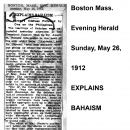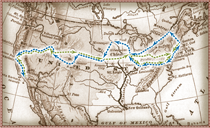Main menu
- ‘Abdu’l-Bahá’s Journey
- World Peace
- Stopping Racism in America
- Empowerment of Women
- More Principles...
- Prayer for America
Explains Bahá’ísm
Dr. Fareed’s Address Followed by One on the Philippines.
The teachings of Bahá’ísm were expounded yesterday afternoon at the Twentieth Century Club by Dr. Ameen H. Fareed, interpreter to the head of the cult, ‘Abdu’l-Bahá. “Anybody,” said Dr. Fareed, “may join Bahá’ísm without giving up either his church or his nationality, for Bahá’ísm means love, charity, kindness to all — in short, the fatherhood of God and the brotherhood of man. The fundamental principle of Bahá’ísm is that while religions are many, religion is one.”
Atherton Brownell, a newspaper correspondent recently returned from the Philippines, told the club of the work of Maj. John P. Finley among the Moros. The narrative included an account of Maj. Finley’s success in winning the natives from their warlike habits to the methods of civilized life.
“One of the things done,” said the speaker, “was the foundation of the Moro Exchange for the delivery and sale of commodities. Its total sales the first year amount to $240,000. Some 32 branch exchanges have been started, and the aggregate sales up to 1910 reach upwards of $4.000.000. Meanwhile, throughout the territory in Mindanao reached by these exchanges the natives have voluntarily given up their arms, while elsewhere in the Archipelago arms are being obtained by the process of killing men.
“The effect of Maj. Finley’s pacificatory policy on the Moros is shown by the fact that their representatives, in petitioning the secretary of war, asked him, in case independence should be granted to the archipelago, to allow their island to be annexed to the United States. Maj. Finley has just returned to the United States in view of the struggle which is now on at Washington — the struggle which is to decide whether his peace methods are to be extended to the rest of the Philippines or whether the method is to continue to be that of rapid promotions because of the number of men killed.









